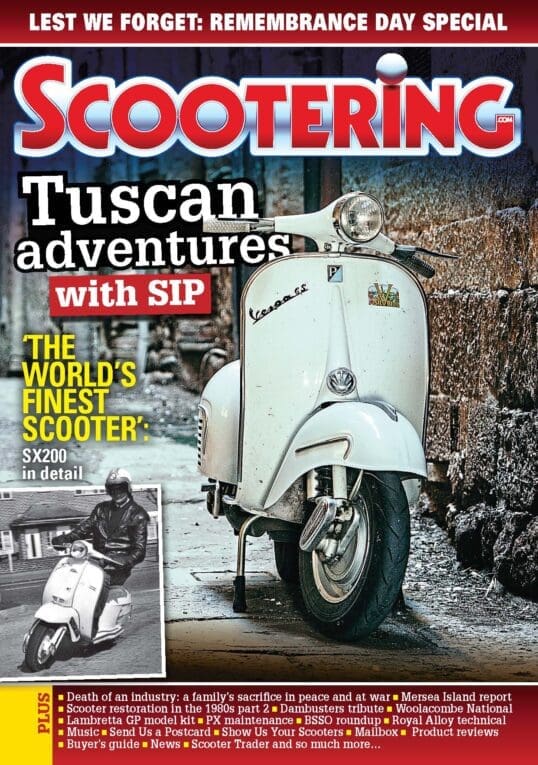The dictionary definition of peacocking, in reference to males, says that it means dressing for attention. Like peacocks using their feathers to attract a mate.
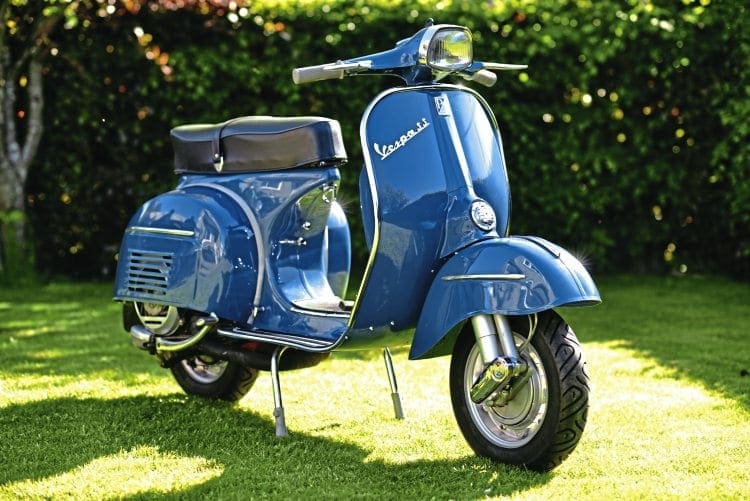
Dundee-based Raymond Stewart, Ramie to his mates, has had an obsession with scooters that has grown ever since he was an apprentice mechanic. It started with the PK 100 Vespa which was initially functional transport for work. Over the ensuing 33 years, he has amassed an impressive collection which, at its peak, amounts to almost a small fleet. As an 80s scooterboy, his preference has inclined towards modified machines, predominantly chops and cutdowns. Not that his leaning in that particular direction excludes standard, or standard appearing scoots, especially classic models. Two superb examples of desirable, sought-after 1960s Vespas are an integral part of what Ramie has acquired — his 1966 SS90 small frame and his 1965 SS180. Both scooters are in one of the standard colours they were offered in when new, peacock blue. Both of Ramie’s mid-60s Vespa SS models are pristine examples, which undoubtedly attract green-eyed looks of envy from fellow Vespa enthusiasts.
Peacock suit
The back story to how Ramie ended up with his ’65 SS180 begins some 10 years ago: “I’d been looking for an SS180 for a while, I’d made it known through a variety of different avenues that I wanted one. VCB came up trumps, putting me in touch with a lad way up in the North of Scotland who had one for sale. It transpired it had belonged to his uncle, who had bought it from new some 30 years before.

“I contacted the lad asking how much he was looking for as I didn’t want to travel all that way and come back empty handed. He wouldn’t give a price but did say don’t worry, you’ll be going home with it, just bring some money with you. I took a stack of cash with me. When I first set eyes on it my legs nearly turned to jelly, apart from a few bits of minor restoration required, it was near perfect. Asking again how much the lad was looking for, this time face to face, his response was, “Give me £80 for it.” Even 10 years ago that was an unbelievable price for a classic S5180 in decent condition. Needless to say, I snapped his hand off. I took it home, carried out the small bits of restoration required. Then, largely due to other projects, it took up residence for a couple of years.

“A mate of mine had his eye on that very SS180 for a while, continually badgering me to sell it to him. Eventually, he persuaded me to sell, which I regretted almost straight away. I bought an SS180 frame and panels off a mate for a decent price, I had picked up a Rally 200 engine at some point which had subsequently been in my garage for some years, I decided to marry the Rally engine with the SS frame. I had loosely intended to convert a standard SS180 engine into an SS200. After the nightmare experience of locating and acquiring forks, headset and other genuine parts it worked out more cost effective to rebuild the Rally 200 and fit that to my SS180. It took me about six months to do all the work including painting, as well as rebuilding the engine with all new parts. So far it’s got less than 200 miles on the clock, which is something I intend to redress this year by riding it to a few rallies, shows and events. In comparison to my tuned GS, my SS drives very nicely and very smoothly.”

Very nice, now put it back in your trousers!
The Super Sprint 90 Vespa, is without question the most desired, lauded and sought-after of all Italian made small frame scooters. The second-hand market price tag continues to spiral upwards, edging towards five figures for complete, concourse quality examples. Aimed at competition Vespa riders, the SS90 has been pretty much ever present on the starting grid of every discipline of various scooter sports events in the UK, ever since its launch in 1965.
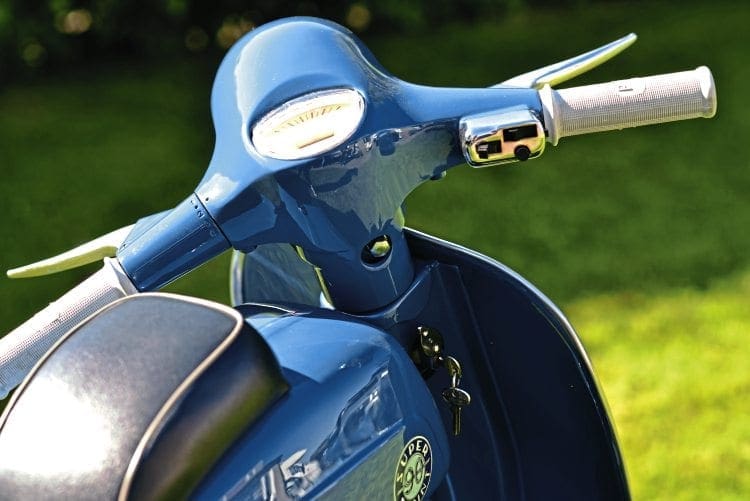
As a scooter enthusiast who has been amassing a collection over a number of years, sooner or later Ramie was going to be looking to acquire an SS90. “Once I decided to look for an SS90, I knew it was going to prove to be costly, but I was prepared for that. What I found absolutely astounding was the vast amounts being asked and often being attained, for absolute basket cases —total wrecks. I like to think I’m quite handy at carrying out various types of restoration and refurbishment myself. I’d carried out various necessary work on every scooter in my collection, so my hunt for an SS90 wasn’t hampered by the prospect of having to get my hands dirty. Working offshore, in my downtime I found myself tracking, and tentatively bidding on several different SS90 scooters over a period of time. The last one I had under consideration was in a far from decent condition; for starters the floor was rotten. I found myself getting outbid on an offer of £8000 on a well-known auction site.

“This was an eureka type of reality dawning moment for me — if I spent a few extra pounds I could obtain a near pristine SS90? That is exactly what I did. Goidie Ray helped me locate what is probably the best SS90 in the entire UK. Restored by Darren Kane, who I bought it off, it really is a little beauty. Which is what I call it; Little Beauty has picked up a few awards at a number of shows locally to me. It’s a real pleasure to ride and it handles like a dream too, it’s 100% standard, my only slight criticism being it could maybe do with a bit more oomph. I’ll be riding Little Beauty to various local gatherings this year. It’s the only scooter in my collection that I’ve not had to work on myself, given the amount I paid to own Little Beauty, I’d hope not to need to!”
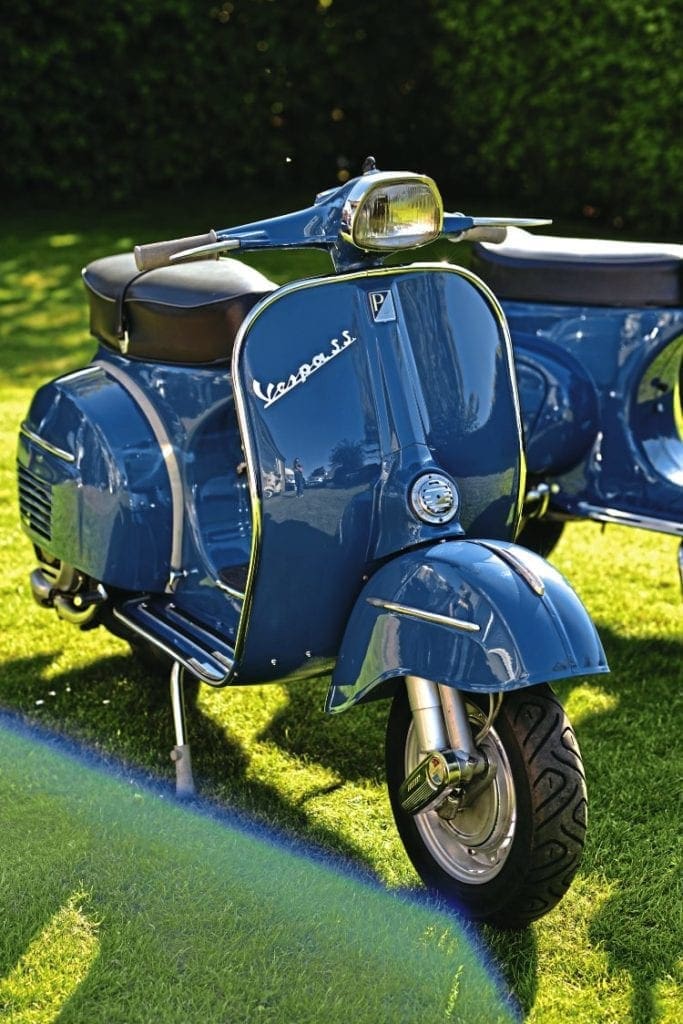
As mentioned in his spec sheet, Ramie has parted company with his wife which, to coin a phrase puts him ‘back in the game’. His pristine pair of Piaggio made classic scooters could well prove helpful should Ramie want to go peacocking, after all, he’ll get a head start given the colour of these two steeds.

OWNER DETAILS
Name: Ramie Stewart
Scooter club & town: Dundee Stars & Stripes.
How and when did you first become interested in scooters: I got my first scooter in 1985. I only bought it to get to work as a mechanic, and have one ever since.
What was your first scooter: PK 100.

First rally or event: My first rally was Morecambe ’86.
How did you get there: Went there two-up like most people; no licence, no insurance, no nothing on a P150.
Favourite and worst rally/event: Morecambe was always a fave continuing for mega years. But I like to support out Scottish No1’s and Kelso has one of the best scooter rallies in the country.
What’s the furthest you’ve ever ridden on a scooter: Well everywhere can be far from North Scotland, ridden to Margate, Brighton, etc.
What do you dislike about rallies and events: My biggest grump is the snobbery. People complaining about how people get to rallies… cars, vans, campers, etc. Our scene needs support – I don’t give a f**k how they get there, they have made the effort to get there and support the rally. We aren’t 21 anymore, we all have different life commitments. In an ideal world it would all be scooter riders and their scooters. But it’s not like that so f**king get over it and get back to enjoying what we are there for.

Name of scooter & reason: Little Beauty
Scooter model: SS90.
Date purchased & cost: This is the first scooter I’ve ever bought and not built. I tried so hard to find one but the prices for wrecks were shocking so I decided to find the very best one, and this is the best one in the country.
Inspiration for project: I was building a private collection and really wanted one for myself.Is
there anyone you wish to thank: Goldie Ray
Stewart for helping me find it. Darren Kane for letting me have it.
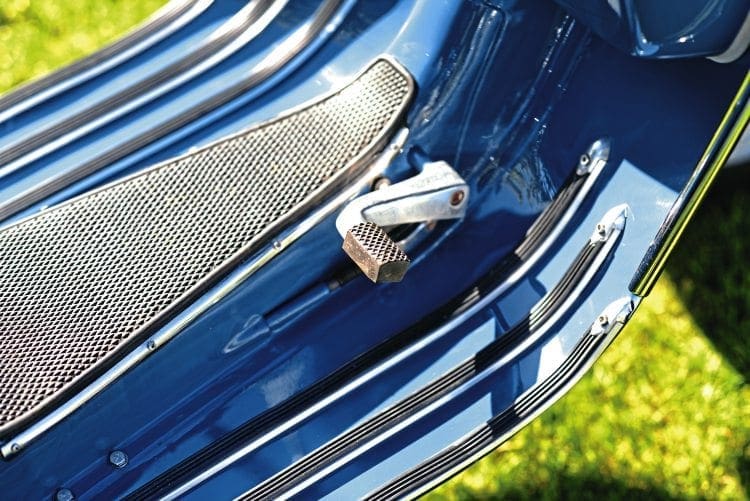
Scooter model: Super Sport 180
Date purchased & cost: Bought it as a frame and panels from a mate Dunf, price I cannae remember. I’m sure it was fair price, he owned it for 10 years if I remember right.
Inspiration for project: I restored one about 10 years ago for myself but I sold it, really should have kept it.
Time to build & by who: It took me about six months and I did all the work.
Paintwork & murals done by: Paintwork myself.
What was the hardest part of the project: Finding all the missing parts.
Is there anyone you wish to thank: I’d like to thank my ex-wife for not forcing the sale of these scooters to buy her out of my life. This is actually one of the lucky ones that I managed to save after the collection I had built up was destroyed.
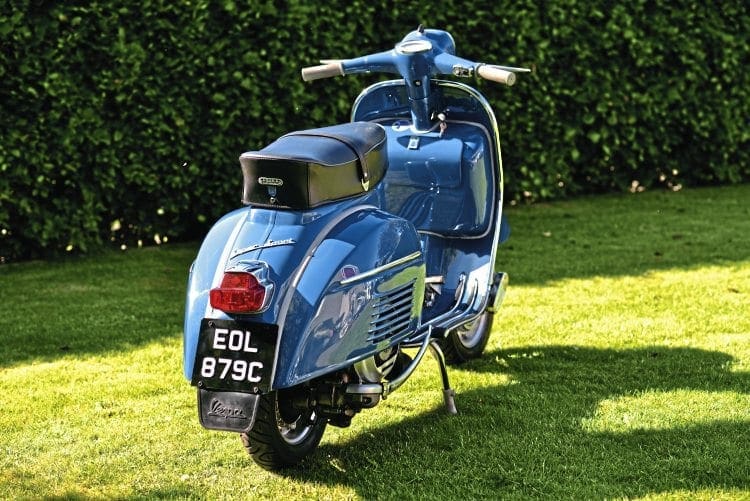
VESPA MODEL FACTS
VCSIT SS180
VespaUp until its launch what became the SS180 was planned to be the GS Mark 3. Early owner handbooks confirm that this was Piaggio’s initial intention.
At the time of its launch in 1964, the SS180 was the most powerful and fastest production Vespa made. According to the technical specifications it produced 10bhp, giving a top speed of 65mph. Bore was 62mm and stroke was 60mm, giving 181cc. It was the last large frame Vespa model with a piston ported engine. The SS180 was offered in three different colours, red, white and blue. It is perceived as being the first Vespa model to be offered as a dealer special in the UK.
The Grimstead Hurricane, offered by Eddie Grimstead, is arguably the best-remembered example.
V9SS1T SS90 Vespa
Launched in 1965, with a production run lasting seven years, a low number of SS90 Vespa scooters were manufactured. A mere 5309 according to official figures, hence the genuine rarity of the highly desired small frame model.
A derivative of the SS90, near identical in frame and bodywork, was the SS50 Vespa, V5SS1T. Powered by a detuned lower capacity version of the SS90, this ultra-rare Vespa was manufactured also between 1965 and 1971, during which time fewer than 2500 SS50 models were built. Top speed is given as 70kph.
When launched in 1965, the SS90 came with all manner of tweaks aimed at making the SS90 more manoeuvrable than its eider sister models. It was offered in four colours, blue, white, red (Monza and later metallic).
Words: Sarge
Photographs: Alex Adair

